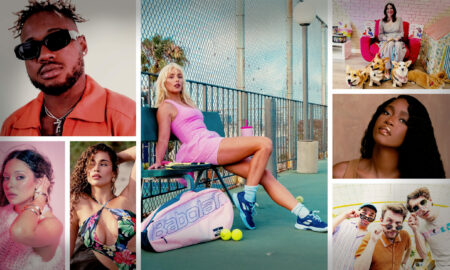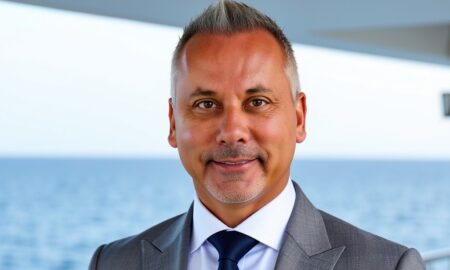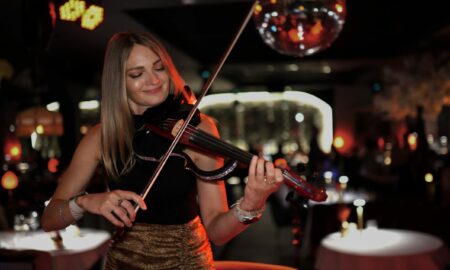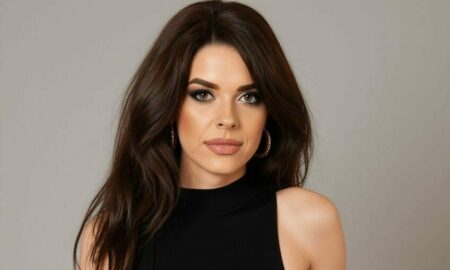

Today we’d like to introduce you to Lynda Sappington.
Lynda always wanted to sculpt, but the art teachers in public schools are nearly all painters. When they did a unit on clay, Lynda made sculptures of horses and cats instead of the bowls and ash trays the other students made. The teachers had no idea how to help her, so she just did the best she could.
In her early 40s, Lynda was creating stained glass panels which were sold through an art co-op. The co-op was run by two ladies, one a painter, one a potter – or so Lynda thought. The “potter,” Sue Bordenkircher, offered a summer clay class for kids that Lynda brought her son to. Sue invited Lynda to “stay and play” which is when Lynda learned Sue was a trained sculptor.
Lynda’s first pieces were cartoony baby dragons because she didn’t think she could do a realistic horse. She did a couple of horses after she learned more about working in clay but they didn’t satisfy her. Then she saw a flier for a black porcelain bust of a Friesian horse that was horrible to someone who knows horses. It had big Arabian-type eyes which are totally wrong on a Friesian. The words “I can do better than that” just fell out of Lynda’s mouth . . . so then she dared herself to try. The resulting piece was cast in resin and sold through a gallery in Del Mar, California, and two galleries in Ohio.
A friend of her daughter’s saw that little bust and told Lynda, “I want your first bronze!” Unsure if she could do an actual portrait, Lynda and that client worked out a deal where the client paid the costs of having a mold made and bronzes cast (one for her, one for Lynda to market), and the stallion being portrayed and Lynda would “exchange labor.” Both the customer and Lynda thought they got the better end of the deal when a beautiful little filly was born the next year and the bust of the customer’s stallion was such a good portrait, people who knew him recognized him even though the bronze didn’t have the stallion’s huge blaze.
Sue Bordenkircher told Lynda she should always say she’s self-taught, because Sue had no idea about sculpting horses. Lynda discovered she works best in plastilene after a lot of experimentation, and she continues to use that to this day, 24 years later. She has taken workshops in anatomy, human sculpture as well as equine, patinas, mold-making and casting resin, making cast silver jewelry and various other topics that have interested her over the years.
Without a formal education in art (her degree is in music), Lynda asks questions of anyone whose work interests her. Lynda keeps notes about things she learns on her computer. Those notes evolved into a book, “Sculpting 101: A Primer for the Self-taught Artist” which sold out its first edition, being ordered by hopeful sculptors all around the world. After she made a complex carriage piece as a World Championship trophy for the Friesian Horse Association of North America (FHANA), her notes on carriage-making prompted her to do a complete revision of her book and add a chapter on carriage-making. There were no books on carriage-making that Lynda could find when she started the project, so her book filled a void in sculpture educational books. The second edition of her book sells on Amazon as well as her website.
Lynda has made portrait bronzes of many famous horses, mostly in the Dressage world, two of which are the top trophies at the Palm Beach Dressage Derby in Wellington, Florida. She made trophies for a Friesian horse show and an Arabian show circuit in California, as well as doing portrait bronzes of several California horses. She also sculpted the only life-size bronze of a Friesian (Nanning 374) outside of Holland. That piece stands at Fenway Farms, Hortonville, Wisconsin.
How did Lynda Sappington get where she is today? Advertising in magazines, having booths at the big dressage shows, having a booth at Equine Affaire in Columbus, Ohio, and Springfield, Mass. for many years, as well as her website (www.TheSculptedHorse.com) and word-of-mouth. Her sculptures have been collected by people all over the USA and Canada as well as several foreign countries. Other pieces made specifically to be trophies have been stakes race trophies at race tracks in the USA and Canada, or year-end awards for various breed groups. The year Funny Cide won the Kentucky Derby and was named “Horse of the Year” by the New York Thoroughbred Breeders Association, all eleven of his owners wanted one of the trophies, so Lynda had to cast more. Three of her bronzes are at the Kentucky Horse Park, one (the World Championship trophy for Concours d’Elegance) in the FHANA headquarters and two in the US Dressage Federation headquarters, one a trophy and the other in the Hall of Fame.
Lynda is a Signature Member and Board member of the American Academy of Equine Art (AAEA), as well as Dean of Sculpture and Dean of Communications. She teaches workshops in her home studio under the auspices of the AAEA, using her book as the textbook. She is happy to mentor people just starting out in sculpture. It’s a way of “paying it forward” to thank all those artists who have helped, and continue to help her on her way.
Great, so let’s dig a little deeper into the story – has it been an easy path overall and if not, what were the challenges you’ve had to overcome?
Struggles along the way include budgeting money to make sure I could pay for molds and bronze and still do some advertising. Other bumps include being self-taught and not knowing about certain materials and techniques, or if I learned about some new material, having to work out on my own how to use it (this was before there were YouTube videos on how to do everything). Not having an art education, though, left me free to do things the way that seemed logical to me, including running my art business as a business, something a great many artists fail to do or even think about.
A big problem for me is being a realistic artist in an art-deprived area that mostly focuses on abstract art. I have rarely gotten respect as an artist in our home area. If I’d been out West where realistic art reigns, I would have had an easier time getting my business off the ground. I think I’ve sold three pieces in our area, while I’ve sold lots of pieces everywhere else, even in Australia, England, Ireland, Canada and Europe.
When I started out in 1993, I got on some art forums online, where nearly everyone was a painter. Still, I stuck with it, learning some interesting things and answering their occasional questions about the business of art. One of those forums had a lot of people with Master’s degrees in art. They told me that selling my art was “prostituting” it. Huh?? I was happily selling sculptures at a decent rate, while they were more interested in getting grants for this or that and put their efforts there. I have never wanted the taxpayers of this country to just hand me money. I want to earn it by selling them something they’ll love for years. I had to learn how to ignore the nay-sayers in the art world and just do things my way so I’d be happy with my business and could continue to create joyfully.
Having a booth at horse shows was always a challenge (I don’t do them anymore). Leaky tents damaging framed reliefs cast in paper, high winds forcing me to put my art back in my Expedition, heat, flies, tornadoes – doing those shows wasn’t a lot of fun, but it got my name out there and resulted in quite a few commissions and trophy jobs. Changing from using tents to using a show trailer that became a gallery once I got it set up brought its own problems., such as getting stuck in a detour and needing to back up around a corner to get out of the mess with nobody to help me watch out for the huge ditch behind my trailer. I made it, but I wasn’t sure I would! Having a booth at an indoor trade show had headaches too. Petty theft (thankfully petty!), a person in a wheelchair catching a wheel on my tablecloth and pulling a bronze down onto the concrete floor and just kept going! Thankfully, the bronze was undamaged. I managed to catch the carriage piece before it fell, too, that one is delicate and would’ve been badly damaged, I’m sure. Showing in galleries has not been as successful for me as showing my work myself, and then there’s the problem of two of my bronzes being stolen from galleries and one being so badly damaged from falling to the floor, it cost as much to repair it as it did to cast it, and bronze is not inexpensive to cast.
Alright – so let’s talk business. Tell us about Whimsy Hill Studio – what should we know?
Whimsy Hill Studio is my art business. I create sculptures, mostly of horses, mostly in bronze, as well as doing some other subjects from time to time. When someone asked if I could sculpt a cougar, I said, “Sure!” then had to figure out how to do it. (It turned out fine!) That kind of thing has happened many times over the years, so in addition to horses, I’ve also sculpted a dragon, a chipmunk, a dog, children and adults. My best work is my equine sculpture.
I specialize in portraying Warmbloods and Friesians. Our daughter is an international-level Grand Prix rider. The magnificent horses I see at her shows inspire me. I’m known for making horses that look like they can breathe, like they can trot right off their stands. People who have seen my work in person have told me that many times. My sculptures also always have sweet faces – they look like the horse I’m portraying, but there’s a sweetness, a tenderness to the portrayal. I don’t do that on purpose, that’s just my style and I like it.
I’m proud of the fact that I can do an accurate portrayal of a horse working only from photos (it’s much easier if I’ve been able to see and photograph the horse in person). Sculpting is difficult because you have to get both sides of the animal/person correct, which means the muscles on one side are doing one thing (striding forward, perhaps) while the other side’s muscles are doing something else (finishing the stride, perhaps lifting the leg off the ground). You have to understand anatomy to get these things right. Getting a horse’s eyes straight is also difficult, because the eyes are set on a “corner” of the head. They have to match from the front of the horse’s face and they have to look right from each side and behind. Getting it right can be really hard on some pieces, but it’s so satisfying when you get it right – and I don’t send a piece off to be cast until I’ve gotten those eyes right.
I’m most proud of two pieces I’ve done of the Friesian stallion, Nanning 374. The carriage piece (“Friesian Elegance”) was commissioned in April and had to be presented as the World Championship Concours d’Elegance trophy for the Friesian Horse Association of North America in mid-October. It normally takes me at least three months to do just a horse. I had to have the horse, the reproduction 17th century Friesian sjees and the driver completed and sent to the foundry in four months, and the foundry had to rush the castings to get it done on time. My chiropractor and body worker both worked hard to hold me together as I worked far more hours a day than was good for me to get the job done. I was able to be part of the presentation when it was awarded for the first time.
The second Nanning piece I’m extremely proud of is the larger-than-life bronze I did as a memorial to Nanning, who died unexpectedly at age 14. I had total rotator cuff surgery two days after I got the commission to do this piece. I had six months of recovery and started sculpting one-handed by about the four month mark. The maquette (small model an enlarged sculpture is based on) I made was scanned and digitally enlarged, then I got to re-sculpt it at 700 times the size of the maquette! That was awesome! I would love to do another life-size or monumental piece.
One of the things that sets me apart from other artists is that I’m very strict about having written contracts for any business between me and a customer, unless it’s just a cash sale. I know many artists who’ve been burned by clients who wouldn’t finish paying or caused some other kinds of problems that were costly to the artist. By taking a businesslike approach, having contracts ready at hand when someone wants to talk about commissioning something or ordering trophies, my customers have a clear understanding of my terms and both of us have a more comfortable experience working together than if nothing was spelled out.
Is there a characteristic or quality that you feel is essential to success?
Optimism. And stubbornness.
Contact Info:
- Address: 3631 Weisenberger Rd.
Lebanon OH 45036 - Website: www.TheSculptedHorse.com
- Phone: 513-932-1907
- Email: [email protected]
- Facebook: https://www.facebook.com/LyndaSappingtonArt/








Image Credit:
Photos by Lynda and John Sappington.
Getting in touch: VoyageLA is built on recommendations from the community; it’s how we uncover hidden gems, so if you know someone who deserves recognition please let us know here.



















